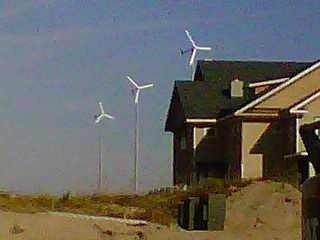
Photo-voltaic (PV) arrays offer a variety of attractive features. They are quiet, reliable, and durable.
They also have some drawbacks. Tree, buildings, and terrain can conspire to hide the sun. Heat buildup under the array reduces PV efficiency. The arrays add structural and wind stress to the supporting roof. The roofline may not be oriented to provide optimal surface area to the sun and may not be of sufficient surface area to provide adequate power for the home. Finally (my favorite), roof-mounted PV arrays provide the perfect hiding place for your kid’s Frisbee.
The article below reports that an Israeli company, Solaris Synergy (
http://www.solaris-synergy.com/), has developed a scalable, floating array that takes advantage of large bodies of water. A floating array has the advantage of an unobstructed view of the sky. Further, the water serves to cool the array by dissipating heat, increasing efficiency.
The following article can be found at Israel National News,
http://www.israelnationalnews.com/News/News.aspx/143904.
by Gavriel Queenann
Israel's Solaris Synergy is one of the companies to see a future in floating solar panels, Green Economy reports.
Such panels would float on agricultural and mining ponds, hydroelectric reservoirs and canals, and similar locations.
In addition to being an efficient use of space, floating solar panels have other economic benefits attached. First, they minimize the use of steel, which is the main cost in the production of land-based panels. Second, the water's cooling effect can increase electricity production over typical ground-mounted systems. And third, a solar system floating on water also reduces water evaporation 70%, while inhibiting destructive algae growth by blocking sunlight on the water.
Solaris engineers say such systems can produce up to 2 MW of electricity per mile.
Solaris has installed its first live floating concentrated photovoltaic (F-CPV) system connected to the Israel Electric Corporation (IEC) grid. The system is based at the Arava Institute for Environmental Studies' Center for Renewable Energy and Energy Conservation located on Kibbutz Ketura, 30 kilometers north of Eilat.
The project is part of Capital Nature Experimentum, a verification and inspection center for new technologies developed by renewable energy companies.
"This installation is a milestone for us," Solaris Synery CEO Yossi Fisher said. "We're confident that it's just the first of many future Solaris implementations in Israel and throughout the world."
Solaris Synergy also plans to float a solar array on a reservoir in the south of France in a trial with French utility EDF.
(IsraelNationalNews.com)
 KGTV Channel 10 reports that San Diego has become a center of renewable energy research in the field of algae fuel. Southern California receives a great deal of sunlight, required for aggressive algae growth. Nearby Imperial Valley provides cheap, non-arable land for production. Algae growth requires relatively little water, a good fit for a desert operation.
KGTV Channel 10 reports that San Diego has become a center of renewable energy research in the field of algae fuel. Southern California receives a great deal of sunlight, required for aggressive algae growth. Nearby Imperial Valley provides cheap, non-arable land for production. Algae growth requires relatively little water, a good fit for a desert operation.





